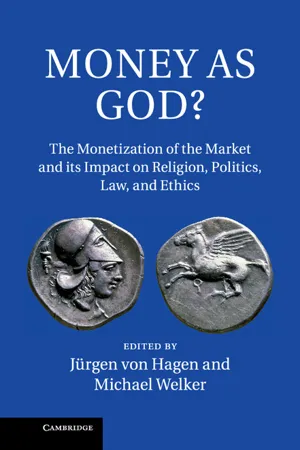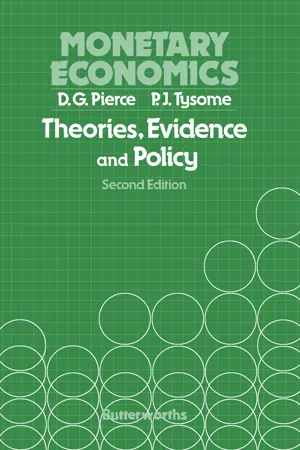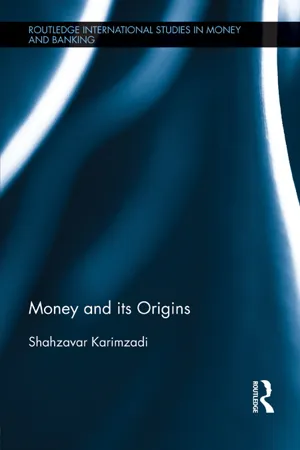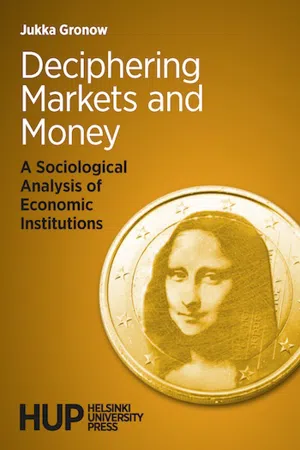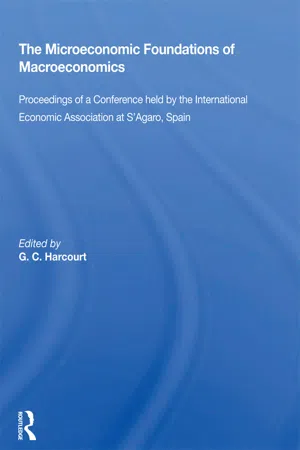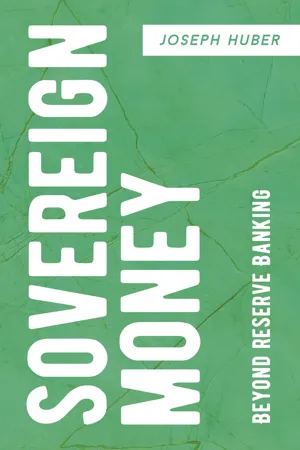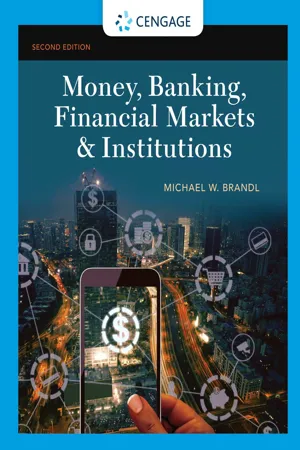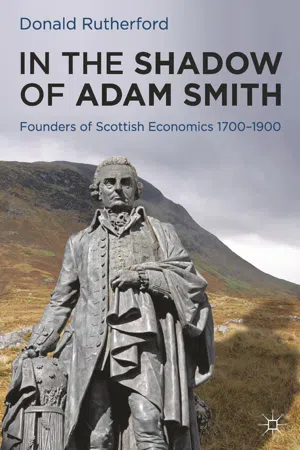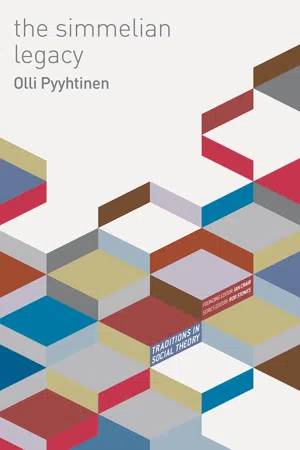Economics
Money Definition and Function
Money is a medium of exchange that facilitates transactions by serving as a universally accepted form of payment. It also functions as a unit of account, providing a standard measure for the value of goods and services. Additionally, money serves as a store of value, allowing individuals to save and transfer purchasing power across time and space.
Written by Perlego with AI-assistance
Related key terms
1 of 5
12 Key excerpts on "Money Definition and Function"
- eBook - PDF
Money as God?
The Monetization of the Market and its Impact on Religion, Politics, Law, and Ethics
- Jürgen von Hagen, Michael Welker(Authors)
- 2014(Publication Date)
- Cambridge University Press(Publisher)
Much of this confusion results from the fact that discussions of money often start from an inadequate definition of it, focusing on three functions money supposedly fulfills in an economy. In this tradition, to which even renowned economists adhere, money is defined as anything that simultaneously serves as: (1) a means of payment, (2) a store of value, and (3) a unit of account. That is, “money is what money does.” 3 Defining money in terms of these three functions is awkward, because it contradicts the experience that not everything that assumes these roles in an economy is deemed money in practice. For example, interest- bearing assets serve both as stores of value and mediums of exchange in modern economies where banks offer checkable asset accounts. 2 A. Hingston Quiggin, A Survey of Primitive Money. London: Methuen and Company 1970, 1. 3 O. Issing, Einführung in die Geldtheorie. Munich: Verlag Vahlen, 13th edn. 2003, 3. Hingston Quiggin, A Survey of Primitive Money, replaces the second function as being a symbol of wealth. 20 Jürgen von Hagen Under such circumstances, “dollars” or “euros” are still the unit of account, but no longer the medium of exchange. More generally, Fama argues that there is nothing that requires an economy’s medium of exchange to be its unit of account. 4 In fact, any commodity could serve as a unit of account. 5 While competition and market forces can make an economy switch from one medium of exchange to another, the choice of a unit of account is a problem markets cannot solve easily. A unit of account is an important element of communication among market participants, and its attractiveness depends on how many agents in the economy use it. Therefore, its choice involves economies of scale and network externalities different from those involved in the choice of medium of exchange. Grierson points to historical examples of diver- gences between a society’s unit of account and its medium of exchange, e.g. - eBook - PDF
Monetary Economics
Theories, Evidence and Policy
- David G. Pierce, Peter J. Tysome(Authors)
- 2014(Publication Date)
- Butterworth-Heinemann(Publisher)
The functions, advantages and defínitions of money The major part of this book is concerned with the role of money in the workings of the macroeconomy, i.e. the relationships that are thought to exist between the stock of money and such macroeconomic variables as the level of, and rates of change of, unemployment, interest rates and prices. As a prehminary to these matters, this first chapter will consider the very basic issues of what money is and why we have it at all. We begin by setting out the traditional functions of money. We then look at the nature of a monetary economy and the advantages to be derived from using money. Next we consider some of the various theoretical and empirical definitions of money which have been suggested by economists, and look at the problems involved in trying to enumerate all those assets which are embraced by the definitions. Finally, we set out the official definitions of money that are employed in the United Kingdom. The functions of money The word 'money', as used in economics, has two quite distinct meanings. Firstly, it has an abstract meaning in that it is the unit of account or the measure of exchange value. This simply means that money is a sort of common denominator, in terms of which the exchange value of all other goods and services can be expressed. Money in this sense is simply a unit of measurement, denoting the value in exchange of all goods and services, just as, for example, metres denote length, ohms give electrical resistance, and degrees centigrade give temperature. The use of a unit of account greatly reduces the number of exchange ratios between goods and services. With η commodities, one of which is acting as a unit of account, there will need to be only n-l rates of exchange. Without a unit of account, however, there will be V2n{n-) separate rates of exchange. - eBook - ePub
- Shahzavar Karimzadi(Author)
- 2012(Publication Date)
- Routledge(Publisher)
7 Money originated from its functionsIntroductionIt is a customary convention of almost every economics textbook to open the subject of money by examining its essential definition. The definition most certainly revolves around one or a mixture of the functions of money. The function that cannot escape almost any definition of money is the medium of exchange. This function is inseparable from the theory of the origin of money regardless of whatever definition is being used. When combined with other functions, it can either be the dominant or the subordinate function. That is typically specified either explicitly or implicitly depending on the author’s preference as to the overriding function.Money is a contingent factual entity. It is a social and economic necessity that emerged with specific social and economic conditions. Its necessity discerns no universal law. In view of this reality then one cannot come up with a universal definition of money. The very term “define” presupposes the predicate of universality. A definition of money which can be applied everywhere and all the time is doomed to failure. Moreover, the definition of money that is not constructed from its functions would be no more than a verbal contortion. It remains in concepts that are empty of content. This is why economists either knowingly or subconsciously define money in the context of what money actually does rather than what money actually is. The definition of money then is presented as a description of its functions. Relying on the description of the functions of money leaves room for greater flexibility in case of changing economic environment and the formation of new forms of money.Defining money from its functions liberates it from its abstract form. It is much easier to describe what a form of money does rather than to give an abstract definition of it. An abstract definition that is used in all possible worlds would not last long. The possible worlds are not the same and keep changing. The four functions of money that are more or less commonly acknowledged in textbooks are the functions of money as a unit of account, a medium of exchange, a store of value and as a standard for deferred payments. The origin of money is linked to one or combination of these functions. Chapter 7 - eBook - ePub
Deciphering Markets and Money
A Sociological Analysis of Economic Institutions
- Jukka Gronow(Author)
- 2020(Publication Date)
- Helsinki University Press(Publisher)
It is a medium of exchange, a store of value, and a unit of account. If ‘money is what money does,’ one could well argue that in order for something to deserve to be called money it has to fulfill all three functions. 2 The standard economic theory of money concentrates on one of the functions: money as a means of exchange. In these theories, money comes into being as an unintended consequence of the economic rational reasoning of the individuals. 3 As Smith believed, in order to maximize their barter options, astute traders will hold in stock some of the most regularly exchanged commodities that they expect others will accept in the future in exchange for the goods they possess. Consequently, one of these, more or less gradually, and as if by chance, emerges from among all the myriad options on offer as the general media of exchange, mainly because of its advantageous material properties, such as durability, divisibility, and portability. In various historical periods, different kinds of valuables have acted as means of exchange, for instance, furs in the Novgorod Russia’s fur trade with Western Europe or huge stone rings in ancient Polynesia. Finally, a generally accepted coinage emerges, as if crystallized out of all available options, the value of which is based on the extraordinarily high value of precious metals. The general media of exchange, or money, allows for the natural process of barter trade to develop into more extensive and general exchange of commodities, and finally to a fully fledged market economy. In these mythical genealogies of money, the traders come to realize that their life would be much more convenient if they could trade with each other using a generally accepted commodity, money. Money is, in other words, invented and based on a social contract, as if men had in ancient times come together and agreed on the use of some particular commodity as their general means of exchange - eBook - PDF
- Steven A. Greenlaw, David Shapiro, Daniel MacDonald(Authors)
- 2022(Publication Date)
- Openstax(Publisher)
This chapter discusses what economists mean by money, and how money is closely interrelated with the banking system. Monetary Policy and Bank Regulation furthers this discussion. 27.1 Defining Money by Its Functions LEARNING OBJECTIVES By the end of this section, you will be able to: • Explain the various functions of money • Contrast commodity money and fiat money Money for the sake of money is not an end in itself. You cannot eat dollar bills or wear your bank account. Ultimately, the usefulness of money rests in exchanging it for goods or services. As the American writer and humorist Ambrose Bierce (1842–1914) wrote in 1911, money is a “blessing that is of no advantage to us excepting when we part with it.” Money is what people regularly use when purchasing or selling goods and services, and thus both buyers and sellers must widely accept money. This concept of money is intentionally flexible, because money has taken a wide variety of forms in different cultures. Barter and the Double Coincidence of Wants To understand the usefulness of money, we must consider what the world would be like without money. How would people exchange goods and services? Economies without money typically engage in the barter system. Barter—literally trading one good or service for another—is highly inefficient for trying to coordinate the trades in a modern advanced economy. In an economy without money, an exchange between two people would involve a double coincidence of wants, a situation in which two people each want some good or service that the other person can provide. For example, if an accountant wants a pair of shoes, this accountant must find someone who has a pair of shoes in the correct size and who is willing to exchange the shoes for some hours of accounting services. - G.C. Harcourt(Author)
- 2019(Publication Date)
- Routledge(Publisher)
7 The Role, Functions and Definition of Money* C. A. E. Goodhart BANK OF ENGLAND I DEFINITION Money can be and has been defined in many ways. For statistical purposes the stock of money is often defined in terms of certain clearly distinguishable, but analytically arbitrary, 1 institutional dividing lines. Since the dividing line between monetary and non-monetary assets is, perhaps, arbitrary, (e.g., whether or not term deposits at banks, or savings banks, or other financial intermediaries should be included), the choice of assets to be included in the definition of money may be taken on pragmatic and empirical grounds. For example, money might be defined as that set of liquid financial assets which has both a close correlation with the development of the economy, and which is potentially subject to the control of the authorities. Attention then becomes focused on the fluctuations of that set of assets giving the clearest indications of the development of the economy and of the authorities' efforts to influence that development. Such a pragmatic approach, selecting the definition on the basis of ex post statistical correlations, leaves one no wiser about the role of money. 2 Why should the statistical construct, the stock of money, vary in certain predictable ways with the level of economic activity? Why is it held at all? To answer such questions it is necessary to begin by enquiring what particular functions money fulfils. A standard economic approach to defining a particular commodity, or industry, is to examine the cross-elasticities between it and other potential substitutes, in this case between monetary and other assets. Only if such *Most of this essay is a redraft of Chapter I of my Money, Information and Un-certainty (London: Macmillan, 197 5). I am most grateful for comments and suggestions from A.- eBook - PDF
Sovereign Money
Beyond Reserve Banking
- Joseph Huber(Author)
- 2016(Publication Date)
- Palgrave Macmillan(Publisher)
Basic bank- ing structures, too, played a role in classical Greece and Rome. In Christian Europe, banking and finance emerged in the high and late middle ages and became fully fledged in early modernity with deposit taking, letters of credit (important in long-distance trade), double-entry bookkeeping and current accounts for the clearing of claims and liabilities. The habitually stated three functions of money have thus already been identified, traditionally referred to as the functions of serving as a unit of account, a medium of exchange and a store of value. In order to better reflect relevant realities, these functions might be restated as follows: 1. The currency function of money: the existence of a monetary unit of account which enables pricing (attributing monetary value to items) and accountancy. Today, such units of account exist primarily in the form of the official currency of a nation-state (such as the dollar, pound, yen, yuan) or a community of nation-states (such as the euro) 2. The payment function of money: the use of tokens as a means of payment, or to put it another way, using money denominated in a currency for the settlement of any kind of claims and liabilities 3. The income function: money used as a vehicle for transferring income (in the broadest sense), which in turn allows real and financial expenditure 4. The capital function: money used as a vehicle of capital formation. The latter function has a meaning that is different from the traditional notion of money as a store of value or stock of wealth. While silver coins and gold bullion were undoubtedly real valuables, not just monetary items, the value of modern token money is conferred value, which is uncertain over time and basically no more reliable than the price of goods or the value of financial and real assets. The value of money is as certain or uncertain as is the value of income and capital generated through the uses of circulating money. - Michael Brandl(Author)
- 2020(Publication Date)
- Cengage Learning EMEA(Publisher)
How does some “money” lose its store of value? Most often the cause is inflation. Think about what inflation—the continuous, ongoing increase in the general level of prices—means in terms of money. When there is inflation, you have to give up more units of a currency to buy the same amount of goods. Therefore, as an economy suffers from inflation, the currency is losing its store of value. Thus, for an asset to function as money, it must perform three important functions: medium of exchange, unit of account, and be a store of value. However, we also need to consider ques-tions about the amount of money. That is, is there an optimal amount or growth rate of money? We turn our attention to this important issue in the next section. SECTION REVIEW Q1) What is the difference between money and currency? When are they the same? Why might they be different? Q2) How many prices must a barter economy have if the economy has four goods? What if it has 400 goods? Explain why having a money in the second case is beneficial. Q3) You read a news story about a country that is suffering from rapid, ongoing increases in the cost of living. Which characteristic of money is being directly negatively impacted in that economy? a. Unit of account b. Medium of exchange c. Store of value d. Double coincidence of want Copyright 2021 Cengage Learning. All Rights Reserved. May not be copied, scanned, or duplicated, in whole or in part. Due to electronic rights, some third party content may be suppressed from the eBook and/or eChapter(s). Editorial review has deemed that any suppressed content does not materially affect the overall learning experience. Cengage Learning reserves the right to remove additional content at any time if subsequent rights restrictions require it.- eBook - ePub
Money, Enterprise and Income Distribution
Towards a macroeconomic theory of capitalism
- John Smithin(Author)
- 2008(Publication Date)
- Routledge(Publisher)
In the classical economic sociology literature it was also Weber (1978, 2003) who made the arguments that a money of account is the prerequisite for rational accounting, the publication of price lists and financial results, and for the calculation of profit and loss generally. This view was also shared by the economist Keynes (1930, 3) who says quite clearly and unequivocally that “[m]oney-of-account … is the primary concept of a theory of money”. Ingham (2004, 21–3) explains that “money of account makes possible prices and debt contracts … money accounting, with or without an actual ‘money stuff’, is the means by which modern market exchange is made possible … producing action at both spatial and temporal distance”. In other words, for business operations to be conceivable at all there must be some mechanism whereby payments actually can be made, and profits can be realized in some socially objective form, not reducible to subjective private utilities.Money as a unit of account and means of payment
Dow and Smithin (1999), drawing on Hicks (1989), further identify an important element of a monetary economy as the existence of a unique ultimate or final monetary asset in which the twin functions of the unit of account, just discussed, and means of (final) payment are actually combined.4 Contrary to suggestions made in the “new monetary economics” (NME) literature of the 1980s (Fama 1980), these two specific functions are inseparable. The NME literature, though, tended to confuse this issue by talking mainly about the separation of functions at the level of the medium of exchange, again showing the influence of the standard barter exchange theory (Smithin 2003a). This idea of an ultimate monetary asset corresponds to what is known as base money in mainstream literature or valuata money - eBook - PDF
Money and the Modern Mind
Georg Simmel's Philosophy of Money
- Gianfranco Poggi(Author)
- 2023(Publication Date)
- University of California Press(Publisher)
For under these circumstances A can use some amount of the X in his control in order to acquire b from B, who in due 136 Money course can decide into what to convert that amount of X (263; 210). Whatever functions as X in this example constitutes money; and the point of money's existence is ultimately to convey, by being expended and received, the individ- uals' valuations of objects intrinsically apt to satisfy their desires, while money itself cannot do this directly, for money possesses no value of its own (197; 168). But money expresses and represents those valuations in a uniquely effective manner; and in this critical capacity (245; 198) are grounded all of money's functions: both the primary one (acting as a means of exchange) and the derivative ones, such as "storing and transferring value" and "measuring" it (179; 156). Its capacity to ex- press and represent valuations, furthermore, indicates that money is at bottom a symbolic phenomenon, shar- ing with other symbols the uniquely human ability to let something stand for something else (162-66; 146—49). II. Properties of Money Money can perform various exchange functions be- cause, and to the extent that, it has some distinctive properties. Once more, Simmel is hardly systematic in his treatment of those properties, which furthermore is at times somewhat diffuse. This second aspect of his treatment is easier to improve on, simply by being suc- cinct; as to the first, I try to systematize somewhat Sim- mel 's treatment by grouping most of the properties he mentions into a much smaller number of what I call "conceptual clusters," that is, sets of closely associated qualities. I try to design the clusters so as to maximize the overlap between the properties within each and Money 137 minimize the overlap between the clusters themselves; but this second condition is less easy to satisfy than the first. - eBook - PDF
In the Shadow of Adam Smith
Founders of Scottish Economics 1700–1900
- Donald Rutherford(Author)
- 2017(Publication Date)
- Red Globe Press(Publisher)
3 Money Functions of money In 1707 Scotland lost its own currency, the Scots pound, and entered into a monetary union with England. To have one’s own currency is a great mark of independence because a currency sets the prices at which the country trades with the rest of the world. In such currency mergers, there is always the prob-lem of the weaker country having an inappropriate exchange rate, as well as less influence on its monetary affairs. However, the creation of a free trade zone gave Scotland a chance of improving its trading performance so that it could cope with a British currency. Important issues, of perpetual interest to the stu-dent of monetary economics, were discussed repeatedly by the Scots: the nature of money, whether it is neutral with respect to the real economy, the validity of the quantity theory of money, the use of a standard for the value of money, the price for using money (the rate of interest) and whether usury laws should regulate interest rates. The nature of money In the increased activity of the exchange economy, barter was soon found to be too clumsy a method for conducting transactions. There was the problem of the ‘double coincidence of wants’, that is, the problem that the surplus output one party had needed would be wanted by another party, who had a surplus of what the first party wanted. It was better to choose something regarded as valuable for use as an intermediary. Thus money emerged as an institution noted for its efficiency. Aristotle had suggested that money has the function of being a medium of exchange, as well as a unit of account and store of value, setting the agenda for much of monetary economics. In Book I, chapter IV of the WN Smith explains the inconvenience of using barter as an exchange mechanism without first having established a universally acceptable medium of exchange. He noted that, in order to barter, either there has to be a coincidence of wants or each party has to maintain stocks of many goods. - eBook - PDF
- Olli Pyyhtinen(Author)
- 2017(Publication Date)
- Bloomsbury Academic(Publisher)
By mediating subjec-tive valuations and providing the exchanging parties an objective measure of value, money forges a metamorphosis: via money, value becomes an objec-tive, measurable, and reified social fact. Exchangeability is materialized in money. And because money can be used for whatever economic purposes ([1900/7] GSG 6, p. 268, 436), both parties of exchange get a chance to acquire precisely what they desire: while the one receives an object that one aspires, the other receives in exchange what everyone wants – money ([1900/7] GSG 6, p. 388; 2004, p. 292). Money is that which everyone appreciates, because with it one can acquire whatever one desires. Simmel suggests that money is thus ‘the pure form of exchangeability’ ([1900/7] GSG 6, p. 138; 2004, p. 130). It has no meaning outside exchange rela-tions, but its sole purpose is to be passed around, to be exchanged for other objects and measure their value. Money has no significance and value in itself, but only in relation to other objects. Money acts both as a means of exchange and as a measure of value. This makes it ultimately a double, not only in the sense of having a dual role, but also in having two contradictory characteristics. On the one hand, as a means of exchange, it does not remain unaltered through its various uses but pre-sents and preserves its identity only in and via ‘the greatest and most changing variety of equivalents’ ([1900/7] GSG 6, p. 301; 2004, p. 234). Simmel observes the convenience of the expression ‘liquid’ ( flüssig ) money: like a liq-uid, money ‘lacks internal limits and accepts without resistance external limits that are offered by any solid surroundings’ ([1900/7] GSG 6, p. 691; 2004, p. 495). Money is indeed analogous to a fluid, keeping its shape for only a relatively short period of time. What is decisive for money is its flow. It has to circulate and remain in motion in order to function as money: ‘The meaning of money lies in the fact that it will be given away.
Index pages curate the most relevant extracts from our library of academic textbooks. They’ve been created using an in-house natural language model (NLM), each adding context and meaning to key research topics.
